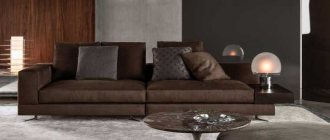Art objects and collections in the interior
People have always had a desire to make their home cozy and exclusive.
For this, various materials, decorative elements, handicrafts and much more are used. The art objects and collections in the interior make the space unique. These can be large or miniature sculptures, designer items, paintings, photo and textile collages. Sometimes one handmade item can become a collecting idea.
Sculptures have always been popular when decorating a home. Their size spoke about their role in the interior: large statues served as protection for housing and were installed at the entrance to the house.
They personified external superiority over those entering the house, in contrast to smaller figures that served as talismans for their owners. The materials used for production varied from paper to marble. Thanks to this, the items fit into any style.
Currently, the sculpture serves a purely decorative function. Experts recommend that before purchasing items, you take a test showing which type of sculpture is more suitable for a particular interior. You need to choose one from three options: bust, statue or sculptural group.
Next, you need to determine what genre the items will be in. You can choose from historical themes, portraiture, animal figures, and so on. Then you should select the material from which the item is made: plaster, porcelain, metal, paper, wood, and so on.
The choice of size will determine its location in the interior. Thus, it is better to place large figures on special stands, pedestals, and small figurines on fireplaces, chests of drawers or shelves.
Regardless of the size of the art objects, you need to allocate free space for them in the interior. You can also use additional lighting for the shelves or stands on which the figures are placed. This will highlight them in the interior and emphasize their uniqueness.
When imagining which pieces of art and collections in the interior would suit the owners, designers usually rely on generally accepted standards. The wealth of home owners is often emphasized by the presence of icons framed in gold or silver. Sometimes icons are decorated with stones, which adds value to them.
When choosing paintings, you need to take into account their potential location:
- If this is a living room, designers recommend choosing a calm, family-friendly type of canvas; for example, it could be a landscape of mountains or forests.
- It is better to hang paintings in the kitchen depicting a still life or beautiful flowers.
- The bedroom is a place of relaxation, so it is better to choose an image with paired objects. These can be animals, flowers, portraits and so on.
- The office can be decorated with views of hunting, mountains, water. There is an opinion that this will give the owner greatness and bring prosperity to the house.
- A child's room is the easiest to decorate. If a child draws well, then these can be his framed paintings. If not, then you can choose fairy-tale heroes or his favorite characters.
- For a girl, paintings depicting flowers and birds are suitable.
To highlight the beauty of the canvas, it should be placed on a plain wall, where there is a minimum of artificial light and a maximum of sunlight.
Experts in the field of painting adhere to one golden rule: much does not mean beautiful.
Restraint in art is always highly valued, so if there are several paintings of the same type in the house, then it is better to place them like a gallery. Then the decor of the room will become more comfortable and original.
Whatever art objects and collections the owners place in the interior, they should remember that one unique element is better than many ordinary ones.
On the topic: methodological developments, presentations and notes
Modular paintings are more than the original format. This is a complete transformation of your interior! The form of the picture does not affect the content and plot, but it does have a damn strong influence on it.
Presentation for a technology lesson in 6th grade.
The material was prepared for 6th grade students in technology lessons on the topic “Cross stitch”.
This material is a technological map of a lesson in grade 7 on the section “Interior of a residential building.”
Lesson topic: Creative project “Objects of art, collections in the interior of a residential building.” Purpose of the lesson: organizing students’ activities to develop graphic skills.
Planning a technology lesson on the topic “Paintings and collections in the interior”, 7th grade date: 03/29/2017.
Educational purpose of the section:
promoting the development of aesthetic taste in interior decoration with paintings and collections.
Educational:
development of knowledge, skills and abilities among students in the design of premises, placement of paintings and collections in the interior;
creating conditions for systematizing what has been learned, identifying the level of experience in creative activity.
Educational:
development of cognitive interest in the subject, creative abilities, ability to analyze, generalize and systematize acquired knowledge;
Development of the eye, orientation in space, discrimination of color and shape.
Educational:
education of aesthetic taste, ability to work in a team, responsibility.
Know the features of placing paintings and collections in the interior.
Be able to create a design for placing paintings or collections.
How to arrange paintings and collections in the interior?
Materials (visual aids, didactic material, TSO, etc.):
Presentation “Objects of art in the interior”, “You are a master yourself”, video fragment “My collection of costume jewelry. New storage system"; https://www. /watch? v=OkvG2h6xdgo, exercise “Connect correctly.”
Resources (where information on the topic comes from: books, textbooks, Internet, etc.):
, Simonenko housekeeping, 7th grade, M., Ventana-Graf, 2014.
Painting in interior decor
Once upon a time, an icon was an indispensable element of home furnishings. She was encased in silver and gold frames. Additional decoration included precious stones and enamels. Over time, this made the icon not only an object of cult worship, but also a real interior decoration.
Icons as interior decoration
From ancient times, tapestries, tapestries, and paintings came into our homes. It is with them that the residences of wealthy people are decorated today. Often, when decorating rooms, designers use continuous trellis hanging, in which the entire surface of the wall is covered with paintings.
Trellis hanging of paintings
Art, having appeared in the interior in any of its manifestations, certainly fills the house with unique comfort. It is very rare that in any apartment you will not find an etching, printmaking, engraving, photograph, reproduction or painting in the decor. Each such object literally pours out information, and not every one encourages creativity. Some stories are able to share a joyful, bright mood and bring good luck to the house, while others, on the contrary, sow depression, driving everyone who looks at them into despondency.
The painting maintains the bright mood of the interior
What the effect will be depends on the theme of the plot, the color scheme, and the location of the element. These facts only confirm that the selection and placement of paintings in the interior is truly a great art that needs to be learned. When selecting them, you need to think about how the paintings will fit with the rest of the decor accessories and whether they will fit into the existing decor at all .
The paintings highlight the colors of the interior
Much does not mean beautiful. This rule for paintings is more than relevant. Art in the interior does not always have to be carried by a single canvas. It can create the impression of asceticism and fail to become the final touch of a single interior. Too many reproductions will lead to overloading the interior, which will also not add positivity to the atmosphere, so learn to look for a middle ground.
Painting as a central decorative element in the interior
Paintings in the interiors of rooms The painting should bring positive emotions to the house, so try to avoid apocalyptic and battle scenes. And for each individual room, the theme of the works will be specific. In the living room, for example, it is good to hang landscapes and bright canvases in the spirit of impressionism.
Bright painting in impressionism style
The bedroom is a room with a peaceful atmosphere and paintings for it should be in subdued colors with paired images.
Painting in pastel colors in the bedroom
A colorful still life or canvases depicting flowers will bring harmony to the kitchen. Ceramic vases and decorative dishes will be a good addition to painting.
Karina with an image of wild flowers will add coziness to the interior
It is better to enliven the study with mountain landscapes or hunting scenes. The art of painting on such subjects brings the energy of stability, reliability, and confidence to the interior. You can place an image of water in front of the desk, and it will bring wealth and good luck to the owner of the room.
Paintings with hunting scenes bring the energy of stability to the interior
The easiest way to decorate a nursery. The author of the paintings for its decoration can be the child himself. If your child doesn’t have a penchant for drawing, then find something children’s themed for his room. These can be images of animals, fairy-tale characters. A sailboat would be appropriate in a young man’s room. It symbolizes upward movement. A young girl’s room will be very successfully decorated with images of peonies, because these flowers are considered a symbol of a successful marriage.
Children's drawings in frames can become a worthy decoration for a nursery.
The corridors and hallways are somewhat gloomy initially and the bright abstractions that appear in them will be very useful.
A bright painting will enliven the interior of the corridor
As you can see, the role of art in the interior is very diverse. Its elements bring with them not only aesthetics, but also mysticism, and it is the latter that is sometimes lacking in our measured life.
Where should the painting “live”?
Not every painting will be able to stand out when surrounded by rich colors, so the best background for paintings will be a dimly colored wall. In order for the canvas, made in soothing colors, not to get lost on the same pastel background, it needs to be framed in a contrasting frame. A common mistake is placing paintings on dimly lit areas of the walls. For a painting to sparkle with colors, it must be bathed in sunlight.
Abstract painting sets the tone in the living room
Few people know, but with the help of paintings it is very easy to correct the perception of space. Do you want to smooth out the unpleasant impression of the bulkiness of the sofa? Hang pictures above it and it will visually “shrink”.
A bulky sofa will seem smaller if you hang a large picture above it
If there are quite a lot of paintings in the house, you can try to create a real gallery out of them. This will add originality to the interior.
A gallery of paintings will add originality to the interior
Art in the interior and decor styles
In order for the sculpture to fit harmoniously into the environment, it must be selected in stylistic harmony with the interior design. So, it’s good to add plaster masks, antique marble sculptures, and busts of celebrities to the classic decor.
Plaster sculpture in classic interior
The place of porcelain angels, funny little animals, shepherdesses, pastoral scenes - in Provence and Rococo. The Russian style is filled with wooden and clay figurines, painted using the Gzhel technique, as well as nesting dolls, etc.
Matryoshka dolls in the interior
Eastern interiors are a kingdom of bone and bronze figurines of dragons and other mythical creatures.
Oriental sculpture in the interior
Minimalism accepts only products made from natural metal, unpainted wood, and ceramics, and the statues should have a laconic shape and amaze with the smoothness of their lines. They can depict not only animals or people, but also some kind of abstraction. It is permissible to introduce the art of sculpture into the home interior with copies of world masterpieces. In this, sculpture has an undeniable advantage over paintings.
Sculpture of Venus de Milo in the interior
Collecting is one of the most ancient hobbies of man. From time immemorial, the passion for collecting hunting and military trophies and weapons has reached our days. And the first collections can probably be considered beads from the teeth of killed animals on the neck of an ancient man or bundles of scalps of defeated enemies among Indian warriors. This collection of trophies served more to determine the social status of the owner, confirming his exploits and demonstrating his merits.
Collections of weapons, in addition to hunting and military trophies, were also intended to demonstrate to everyone military fearlessness and the memory of the exploits of their owner.
Much later, weapons began to be collected as works of art. And the concept of “collectible” over time came to mean the artistic or historical value of an item. At the same time, collections of rarities became a profitable way to invest money, since over time their value only increased. Collections of paintings, rare antique porcelain, and silver appeared.
But there are also collections that have no monetary value, items in which are of interest only to their collector and are associated with memorable moments of his life, travels or hobbies. And there are, for example, collections carefully collected from objects related to the life of the idol: photographs, autographs, programs, objects that were touched by his hand.
Throughout the history of mankind, collectors have come up with so many collections. It’s even difficult to name objects of art or everyday life from which collections would not be created: from cars to toothpicks, from apartments to labels.
Since childhood, everyone has been familiar with collecting plants for a herbarium, collecting stamps, badges and matchboxes, cars and erasers. You never know how many hobbies there are for a little person who is learning about the diversity of the world around him.
As you grow older, interests change, but the passion for collecting, as a rule, remains. Adults collect antiques, paintings, rare books - if funds allow. Less expensive hobbies are postcards, the same labels and beer cans, stamped crystal (the most common “collection” of the times of socialism).
There are also more exotic hobbies: collecting bells, antique keys, nails, or sailboats assembled with your own hands, and so on.
One of the important questions that arises for all collectors without exception is how and where to store their “treasures”. Because there are collections that require certain storage conditions, for example, fragile items: art glass, butterflies, collections of dried flowers, porcelain figurines, antique dolls.
Such collectibles require special boxes with glass lids, for example, for butterflies or special glass display cases. Recently, furniture companies have been producing such display cases to order or as part of furniture groups for offices, dining rooms and living rooms.
Showcases - vertically elongated cabinets with shelves - are made in several options: a combination of glass and wood, glass and metal or plastic, depending on the style of furniture.
Structurally, showcases usually have a glass door in a frame and glass side surfaces and shelves. And they may have side walls and shelves made of wood material, but solid wood is rarely used, only in expensive models, more often it is veneer of different species (maple, oak, walnut, cherry). Modern technologies provide for the application of a special coating that softens the effect of ultraviolet rays, which increases the color stability of the veneer and the overall durability of the furniture.
Collections can also be stored in open shelving systems, but their disadvantages include the accumulation of dust on the shelves; it is much more convenient to glaze the shelves.
Numismatic collections are stored in special tablet cabinets, where coins are placed in thin flat boxes - tablets - each in a separate box.
The items collected in the collection can be used for interior decoration. So, in a glass display case in the living room, for example, antique dolls, art glass, and small sculptures made of porcelain, bronze, and semiprecious stones look decorative.
The dining room will be decorated with fine porcelain, colored glass and crystal dishes, and silverware.
But collections of watches, pipes, weapons or coins are best placed in glass display cases in an office or library. In this case, coin tablets are made of noble wood, the inside is covered with velvet to match the wallpaper or furniture upholstery, and coins are placed on the velvet.
A children's room can be decorated with a collection of soft toys, cars, and badges. But you need to think about ways to place them. For example, badges are attached to fabric stretched over a frame, which is inserted into the frame like a picture and then mounted on the wall.
The kitchen will gain individuality if it is decorated with collected ceramic plates, antique bottles, vials or wine glasses. And some people like to collect hand-painted tea cans - they are also quite appropriate on kitchen shelves. Such “kitchen” collections usually do not need a display case, unless they are antique dishes. It is enough to hang open shelves, and the plates can simply be mounted on the wall.
When using collections to decorate the interior, the main thing is not to get carried away and not to overdo it, so that your decor does not resemble a craftsman’s shop in an oriental bazaar.
Not all collections can be used for interior decoration; such collections include stamps that are stored in special albums or a collection of postcards. But weapons, especially ancient ones, made with subtle artistic taste and decorated with carvings, inlays, mother-of-pearl, gilding and even precious stones, will be a luxurious decoration for an office, library or living room.
Historically, the custom of hanging weapons on the walls came to us from the East, where they were spread out against the background of carpets - a typical detail of an oriental interior. In the offices of Russian estates of the 18th century, this custom also took root. This is how Turgenev describes the office of a Russian landowner of that era: “...an elegant office, covered with beautiful wallpaper on the walls, with weapons hanging on a colorful Persian carpet, with walnut furniture upholstered in dark green tripe, with a library made of old black oak, with bronze figurines on a magnificent desk with a fireplace...”
But using a collection of weapons to decorate the interior requires maintaining a certain style in the setting - varied, perhaps modernized, but classic options. Then the expensive weapon will look organic against the background of natural noble wood, leather upholstery of sofas and walls covered with fabric.
Thus, the objects that we collect dictate the style of the interior of our home, create its unique aura, telling us about our hobbies and character. And things from different eras, often having, in addition to artistic and historical value, their own destiny, delight with their beauty, grace, and keep memories and secrets.
Author of the article Somova M. M.
***
Stripe. In the interior of the house, she is able to amazingly combine the warmth of home comfort with the elegance of style. Watch and read in our next issue.
***
GOOD TO KNOW
A new washing module from Elica will help you fight dirty dishes and emerge victorious from this battle. A rectangular two-door block (6 color options for facades) is inserted into a steel frame and “covered” with a steel tabletop, and inside there are pull-out bins with compartments for sorting waste and a place to build in a dishwasher.
Source: /zh-l “100% kitchen”/
***
ANNOUNCEMENT! READ INFORMATION ABOUT EXAMINATION, APPROVAL OF RENEWAL PROJECTS AND RENOVATION OF PREMISES HERE
***
HERE YOU CAN VOTE FOR NEW ARTICLE TOPICS AND ADD YOURS TO VOTE











